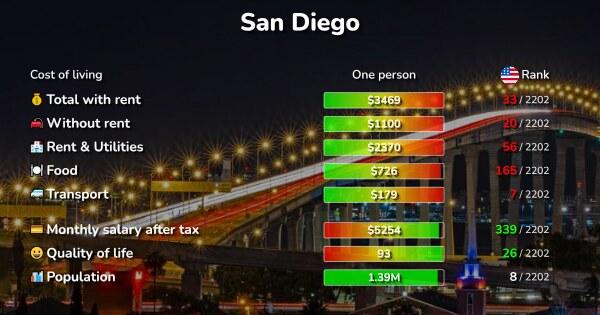The Bureau of Labor Statistics has released its latest report on consumer expenditures in the San Diego metropolitan area for 2022–23, offering fresh insights into the spending habits of residents in this dynamic Southern California region. As inflation and economic uncertainties continue to shape household budgets nationwide, the data provides a detailed snapshot of how San Diegans are allocating their income across categories such as housing, transportation, food, and entertainment. This comprehensive analysis sheds light on key economic trends that are influencing consumer behavior and impacting the local economy.
Consumer Spending Patterns in San Diego Reveal Shifts in Housing and Transportation Costs
Recent data from the San Diego metropolitan area highlights a notable adjustment in how residents allocate their budgets, particularly concerning housing and transportation expenses. With housing costs surging, many households are reporting a larger share of their monthly expenditures going toward rent or mortgage payments, often at the expense of discretionary spending. This uptick correlates with a persistent shortage in affordable housing options, pushing consumers to prioritize shelter over other essentials. Meanwhile, transportation spending reflects a complex shift influenced by fluctuating fuel prices, increased use of public transit, and a rising interest in alternative commuting methods such as biking or ridesharing.
The following table illustrates the evolving percentage shares of housing and transportation within the average household budget for 2022-23 compared to the previous year:
| Category | 2021–22 | 2022–23 | Change |
|---|---|---|---|
| Housing | 37% | 41% | +4% |
| Transportation | 15% | 13% | -2% |
These shifts suggest a growing stress on consumer finances, urging more residents to explore cost-saving strategies like downsizing or using hybrid transportation methods. Key factors driving the changes include rising interest rates impacting mortgage affordability and volatility in gasoline prices pushing commuters towards economical alternatives. Market observers anticipate these patterns will continue as economic conditions evolve throughout the year.
- Housing costs now represent the largest share of discretionary budgets.
- Transportation expenses shrink due to fuel price sensitivity and alternative options.
- Consumer behavior reflects adaptation to inflationary pressures and economic uncertainty.
Rising Healthcare and Education Expenses Impact Household Budgets Across the Region
San Diego households are feeling a significant squeeze as costs for healthcare and education continue to escalate. Many families reported budgeting a larger share of their monthly expenses toward medical bills, prescriptions, and health insurance premiums. Simultaneously, educational fees, including tuition, school supplies, and extracurricular activities, have climbed sharply, placing additional pressure on household finances. This trend reflects a regional pattern where critical services traditionally seen as essential are now major contributors to financial strain.
Data from the Bureau of Labor Statistics reveals key figures illustrating this shift:
| Category | Average Annual Increase | Percentage of Total Household Budget |
|---|---|---|
| Healthcare | 6.5% | 18% |
| Education | 7.2% | 15% |
The rising costs have prompted households to reallocate their spending, often cutting back on non-essential items or increasing reliance on credit. Key adjustments include:
- Delaying elective medical procedures to manage healthcare budgets
- Seeking scholarships and financial aid to offset education expenses
- Prioritizing savings plans to buffer against future increases
Local Retail and Service Sectors Adapt to Changing Consumer Preferences
Retailers and service providers in the San Diego metropolitan area have demonstrated remarkable agility in response to evolving consumer habits. Many local businesses have shifted their focus towards digital platforms, integrating e-commerce solutions alongside traditional storefronts. This hybrid approach caters to a growing demographic that prefers online convenience but still values in-person experiences. Additionally, there has been a significant increase in demand for personalized and sustainable product offerings, prompting shops and service outlets to diversify their inventories and highlight eco-friendly options.
Key trends observed include:
- Increased use of mobile payment systems to streamline purchases and reduce physical contact.
- Expansion of curbside pickup and same-day delivery services, particularly in grocery and food sectors.
- Focus on wellness and self-care services, reflecting consumer priorities in health and lifestyle.
| Sector | 2023 Consumer Spending ($M) | YoY Growth (%) |
|---|---|---|
| Apparel and Accessories | 1,200 | 5.4% |
| Food and Beverage Services | 2,800 | 7.1% |
| Personal Care Services | 950 | 6.0% |
Strategies for Managing Inflation and Supporting Economic Stability in San Diego
San Diego’s economic resilience hinges on targeted approaches to temper inflation’s impact while fostering stability. Local policymakers are advocating for a balanced mix of monetary tightening paired with incentives aimed at boosting productivity and innovation in sectors such as technology and clean energy. These efforts are complemented by increased support for small businesses through grants and streamlined regulations, aimed at preserving employment and encouraging sustainable growth amid fluctuating consumer prices.
Consumer expenditure trends highlight the necessity of practical interventions, including:
- Enhanced public transportation: Reducing costs for residents while alleviating inflationary pressure on fuel and vehicle expenses.
- Affordable housing initiatives: Expanding access to stable housing to curb the cost-of-living surge that disproportionately affects lower-income households.
- Energy efficiency programs: Promoting reduced utility expenses, encouraging local adoption of renewable energy sources.
| Strategy | Key Benefit | Projected Impact |
|---|---|---|
| Monetary Policy Adjustments | Stabilizes price levels | Lower inflation rates by 2024 |
| Small Business Grants | Supports job retention | 3% increase in employment |
| Affordable Housing | Decreases living expenses | Reduces cost-of-living crisis |
To Conclude
In summary, the latest data from the Bureau of Labor Statistics offers a comprehensive snapshot of consumer expenditures in the San Diego metropolitan area for 2022–23, highlighting key spending patterns amid evolving economic conditions. As households navigate inflationary pressures and shifting market dynamics, these insights provide valuable context for policymakers, businesses, and residents alike. Continued monitoring of consumer behavior will be essential to understanding the region’s economic trajectory in the year ahead.







